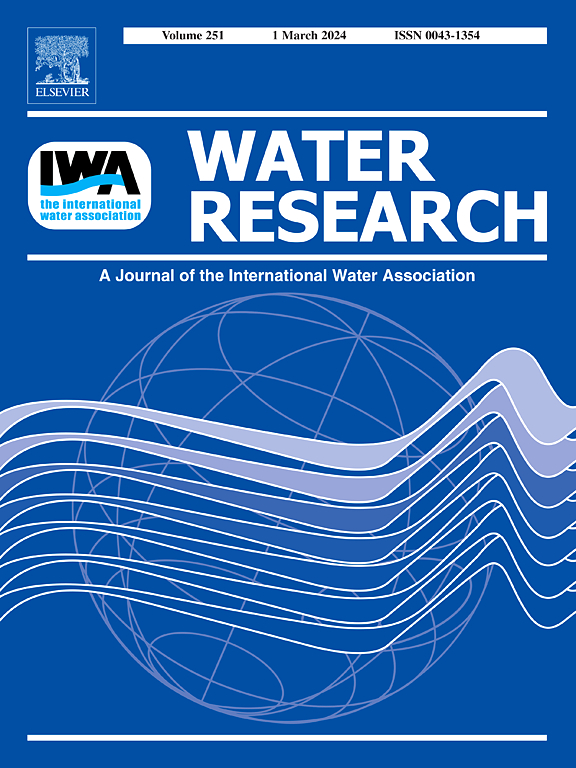State estimation in water distribution system via diffusion on the edge space
IF 11.4
1区 环境科学与生态学
Q1 ENGINEERING, ENVIRONMENTAL
引用次数: 0
Abstract
The steady state of a water distribution system abides by the laws of mass and energy conservation. Hydraulic solvers, such as the one used by EPANET approach the simulation for a given topology with a Newton-Raphson algorithm. However, iterative approximation involves a matrix inversion which acts as a computational bottleneck and may significantly slow down the process. In this work, we propose to rethink the current approach for steady state estimation to leverage the recent advancements in Graphics Processing Unit (GPU) hardware. Modern GPUs enhance matrix multiplication and enable memory-efficient sparse matrix operations, allowing for massive parallelization. Such features are particularly beneficial for state estimation in infrastructure networks, which are characterized by sparse connectivity between system elements. To realize this approach and tap into the potential of GPU-enhanced parallelization, we reformulate the problem as a diffusion process on the edges of a graph. Edge-based diffusion is inherently related to conservation laws governing a water distribution system. Using a numerical approximation scheme, the diffusion leads to a state of the system that satisfies mass and energy conservation principles. Using existing benchmark water distribution systems, we show that the proposed method allows parallelizing thousands of hydraulic simulations simultaneously with very high accuracy.基于边缘空间扩散的配水系统状态估计
配水系统的稳态遵循质量守恒定律和能量守恒定律。液压求解器,例如EPANET使用的液压求解器,采用牛顿-拉夫森算法对给定拓扑进行仿真。然而,迭代逼近涉及到一个矩阵反演,它作为一个计算瓶颈,可能会显著减缓过程。在这项工作中,我们建议重新思考当前的稳态估计方法,以利用图形处理单元(GPU)硬件的最新进展。现代gpu增强了矩阵乘法,支持内存高效的稀疏矩阵操作,允许大规模并行化。这些特征对基础设施网络的状态估计特别有益,因为基础设施网络的特点是系统元素之间的稀疏连接。为了实现这种方法并挖掘gpu增强并行化的潜力,我们将问题重新表述为图边缘上的扩散过程。基于边缘的扩散本质上与控制水分配系统的守恒定律有关。使用数值近似格式,扩散导致系统满足质量和能量守恒原理的状态。利用现有的基准配水系统,我们表明所提出的方法可以同时并行数以千计的水力模拟,并且精度很高。
本文章由计算机程序翻译,如有差异,请以英文原文为准。
求助全文
约1分钟内获得全文
求助全文
来源期刊

Water Research
环境科学-工程:环境
CiteScore
20.80
自引率
9.40%
发文量
1307
审稿时长
38 days
期刊介绍:
Water Research, along with its open access companion journal Water Research X, serves as a platform for publishing original research papers covering various aspects of the science and technology related to the anthropogenic water cycle, water quality, and its management worldwide. The audience targeted by the journal comprises biologists, chemical engineers, chemists, civil engineers, environmental engineers, limnologists, and microbiologists. The scope of the journal include:
•Treatment processes for water and wastewaters (municipal, agricultural, industrial, and on-site treatment), including resource recovery and residuals management;
•Urban hydrology including sewer systems, stormwater management, and green infrastructure;
•Drinking water treatment and distribution;
•Potable and non-potable water reuse;
•Sanitation, public health, and risk assessment;
•Anaerobic digestion, solid and hazardous waste management, including source characterization and the effects and control of leachates and gaseous emissions;
•Contaminants (chemical, microbial, anthropogenic particles such as nanoparticles or microplastics) and related water quality sensing, monitoring, fate, and assessment;
•Anthropogenic impacts on inland, tidal, coastal and urban waters, focusing on surface and ground waters, and point and non-point sources of pollution;
•Environmental restoration, linked to surface water, groundwater and groundwater remediation;
•Analysis of the interfaces between sediments and water, and between water and atmosphere, focusing specifically on anthropogenic impacts;
•Mathematical modelling, systems analysis, machine learning, and beneficial use of big data related to the anthropogenic water cycle;
•Socio-economic, policy, and regulations studies.
 求助内容:
求助内容: 应助结果提醒方式:
应助结果提醒方式:


